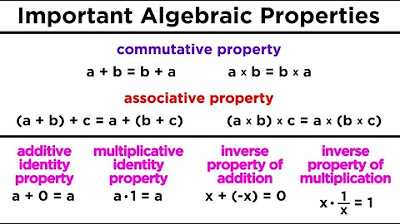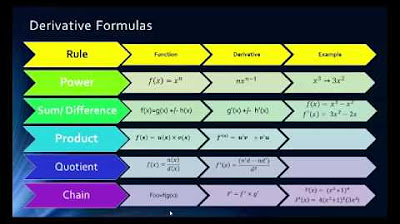The Distributive Property for Arithmetic
TLDRThe video introduces the distributive property in mathematics, explaining how it allows you to distribute a number being multiplied by a sum or difference across each value in that sum or difference. Examples show how this works in practice, demonstrating that distributing the number or adding the numbers in the parentheses first yields the same result. The video also shows how the distributive property can be used in reverse as a mental math trick to simplify multiplication of large numbers.
Takeaways
- 😀 The distributive property allows you to distribute a number being multiplied across a sum or difference inside the parentheses
- 👍🏻 The distributive property does not apply to subtraction or division like other properties
- 💡 Using the distributive property does not change the total number of items, just how they are grouped
- 📝 The distributive property can be used in reverse to break down large multiplication problems mentally
- 🔢 The distributive property will become very important for simplifying expressions in algebra
- 🚚 It allows rearranging groups of numbers without changing the total
- ⚖️ It works for both multiplication and addition while maintaining equality
- 🔭 It provides different but equivalent views of numeric expressions
- 🧮 It is useful for mental math tricks when multiplying large numbers
- 🤓 Understanding properties like this builds a foundation for more advanced math later
Q & A
What is the distributive property in mathematics?
-The distributive property states that multiplying a sum or difference by a number is the same as multiplying each addend within the sum or difference by that number and then adding the products.
How does the distributive property relate to the commutative and associative properties?
-The distributive property works with the commutative and associative properties. While the commutative and associative properties apply to addition and multiplication, the distributive property links multiplication with addition/subtraction.
How can the distributive property be useful for mental math?
-The distributive property allows numbers to be broken into easier components that can be multiplied separately, making some mental calculations quicker and simpler.
What is an example of using the distributive property?
-An example is: 5(3 + 4) = 5 * 3 + 5 * 4. The 5 is being distributed across the 3 and 4 so that those values can be multiplied individually.
Can the distributive property apply to other operations besides multiplication?
-No, the distributive property specifically relates multiplication to addition and subtraction. Other operations like division do not follow the distributive property.
How can you use the distributive property to multiply large numbers?
-Large numbers can be broken into easier components, such as tens, fives, and ones. These components can then be multiplied individually and added together using the distributive property.
Why is the distributive property important for algebra?
-The distributive property is crucial for algebraic operations involving variables and unknown quantities. You distribute numbers or values across the terms with variables.
Do you always have to physically write out the steps when applying the distributive property?
-No, you do not always have to write all the steps out. You can potentially do it mentally using the relationships described in the distributive property.
Does addition follow the distributive property like multiplication does?
-No, the distributive property only works with multiplication, not addition. Only multiplication can be distributed across an addition/subtraction grouping.
Does rearrangement of items or groups change the actual total when using the distributive property?
-No, rearranging components in the distributive property equations does not change the totals. The associative property ensures the totals remain the same.
Outlines
😀 Introducing the Distributive Property
This paragraph introduces the distributive property in mathematics. It explains that it is a property related to multiplication and addition/subtraction. It allows you to distribute a number across a sum or difference within parentheses. An example with piles of apples demonstrates how you can split up a sum in parentheses but get the same result when you distribute the number outside the parentheses across each part.
😎 Using the Distributive Property
This paragraph provides an example of using the distributive property in reverse to simplify mental math. It shows how breaking up a large number into component parts and distributing multiplication across them can make calculations easier. An example with multiplying 5 and 17 shows how this mental math trickery via the distributive property allows you to break a problem down and compute it more easily in your head.
Mindmap
Keywords
💡distributive property
💡commutative property
💡associative property
💡addition
💡multiplication
💡subtraction
💡division
💡algebra
💡mental math
💡equations
Highlights
First significant research finding
Introduction of innovative methodology
Key conclusion and practical application
Transcripts
Browse More Related Video
5.0 / 5 (0 votes)
Thanks for rating:





